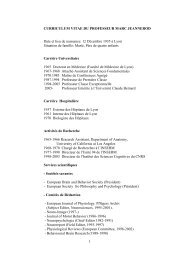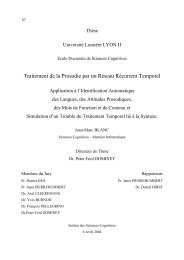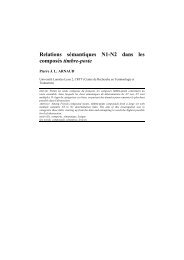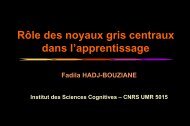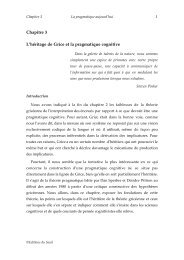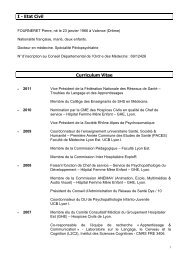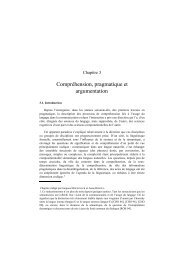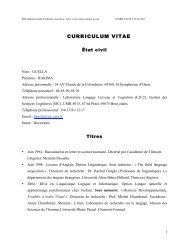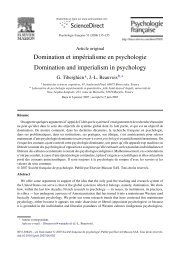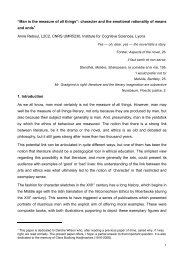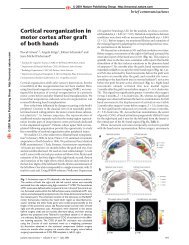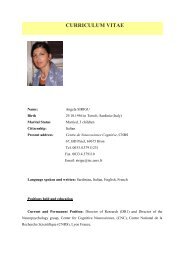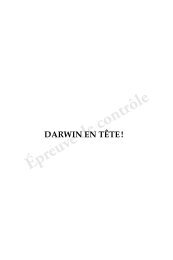Organisation anatomique et fonctionnelle de la sensorimotricité
Organisation anatomique et fonctionnelle de la sensorimotricité
Organisation anatomique et fonctionnelle de la sensorimotricité
You also want an ePaper? Increase the reach of your titles
YUMPU automatically turns print PDFs into web optimized ePapers that Google loves.
<strong>Organisation</strong> <strong>anatomique</strong> <strong>et</strong><br />
<strong>fonctionnelle</strong> <strong>de</strong> <strong>la</strong><br />
<strong>sensorimotricité</strong><br />
Guy Chéron<br />
Université Libre <strong>de</strong> Bruxelles<br />
Laboratoire <strong>de</strong>s Sciences <strong>de</strong> <strong>la</strong><br />
Motricité
Différents types <strong>de</strong> récepteurs
Détermination <strong>de</strong>s champs<br />
récepteurs<br />
Vallbo and Johansson, 1984
(Schmidt, 1978)
Adaptation d’un corpuscule <strong>de</strong><br />
Pacini
Niveau <strong>de</strong> discrimination <strong>de</strong> 2<br />
points
Types <strong>de</strong> fibres afférentes<br />
Taille 2.000 fois > à <strong>la</strong> normale
<strong>Organisation</strong> segmentaire <strong>de</strong> <strong>la</strong> moelle
<strong>Organisation</strong>s <strong>de</strong> 2 voies<br />
<strong>de</strong> transmission <strong>de</strong>s<br />
informations<br />
somatosensorielles.
Voies <strong>de</strong>s colonnes dorsaleslemnisque<br />
médian<br />
Information<br />
V<br />
re<strong>la</strong>tives au toucher<br />
<strong>et</strong> à<br />
o<br />
<strong>la</strong> proprioception.<br />
i<br />
e
Voie spino-tha<strong>la</strong>mique<br />
Informations re<strong>la</strong>tives à<br />
<strong>la</strong> douleur <strong>et</strong> à <strong>la</strong> température
Voies trigéminales
<strong>Organisation</strong> du tha<strong>la</strong>mus
Re<strong>la</strong>tion tha<strong>la</strong>mo-corticale<br />
<strong>et</strong> cortico-tha<strong>la</strong>mique<br />
(Destexhe, 2000, J. Physiol)
<strong>Organisation</strong> du cortex<br />
somatosensoriel<br />
Penfield and Rasmussen, 1952
<strong>Organisation</strong> en colonne <strong>de</strong> l’aire 3b du cortex S1<br />
Récepteurs adaptation rapi<strong>de</strong><br />
(Meissner, Johansson)<br />
Récepteurs adaptation lente<br />
(Merkel, Ruffini)<br />
(Kaas <strong>et</strong> al, 1981)
Voie pyramidale<br />
Cortex moteur
La technique <strong>de</strong> Nauta<br />
•Dégénérescence wallérienne<br />
•Argyrophilie accrue <strong>de</strong>s axones<br />
en voie <strong>de</strong> dégénérescence<br />
Rétro-contrôle du cortex pariétal sur<br />
le premier re<strong>la</strong>is sensitif <strong>de</strong>s neurones<br />
<strong>de</strong> <strong>la</strong> corne postérieure <strong>de</strong> <strong>la</strong> moelle
Mobilisation<br />
isolée segmen<br />
<strong>de</strong> membre<br />
:<br />
Muscles <strong>de</strong>s<br />
membres + axiaux<br />
Muscles<br />
axiaux
Faisceau corticospinal versus<br />
rubrospinal
Voies vestibulospinale <strong>et</strong><br />
tectospinale
Faisceaux réticulospinal médian <strong>et</strong> <strong>la</strong>téral
Test <strong>de</strong> préhension<br />
(D’après Lawrence <strong>et</strong> Kuypers, Brain, 1968)
Double pyrami<strong>de</strong>ctomie
Double pyrami<strong>de</strong>ctomie<br />
+ lésion bi<strong>la</strong>térale du<br />
système ventro-médian
Pyrami<strong>de</strong>ctomie bi<strong>la</strong>térale<br />
+ lésion du système <strong>la</strong>téral<br />
droit
Synthèse chez le singe<br />
(Godaux & Cheron, 1989)
Synthèse chez l’homme
Terminaisons <strong>de</strong> M1 au niveau <strong>de</strong> <strong>la</strong><br />
moelle<br />
(Dum and Strick, 1996)
Terminaison <strong>de</strong> <strong>la</strong> SMA au niveau <strong>de</strong> <strong>la</strong><br />
moelle<br />
(Dum and Strick, 1996)
I<strong>de</strong>ntification <strong>de</strong>s aires<br />
premotrices frontales<br />
Injections <strong>de</strong> WGA-HRP dans M1<br />
Injections traceur fluorescent dans segments médul<strong>la</strong>ires C7-T1<br />
(Dum and Strick, 2002)
Terminaisons <strong>de</strong> M1, <strong>de</strong> <strong>la</strong> SMA<br />
<strong>et</strong> du CMA<br />
(Dum and Strick, 2002)
L’organisation <strong>de</strong>s noyaux <strong>de</strong> <strong>la</strong><br />
base
Marquage du striatum
Lésion du globus pallidus
Synthèse programmation du<br />
mouvement
Synthèse:é<strong>la</strong>boration <strong>de</strong> <strong>la</strong><br />
comman<strong>de</strong> motrice
(Alexan<strong>de</strong>r and Crutcher, TINS, 1990)
DeLong, TINS, 1990
1.0 Introduction<br />
« Each voluntary movement, or change of posture, involves<br />
not only the downward discharge to the peripheral effectors<br />
but a simultaneous central discharge from motor to sensory<br />
systems preparing the <strong>la</strong>tter for those changes that will occur<br />
as a result of the inten<strong>de</strong>d movement »<br />
(Teuber, 1966)<br />
Contrôle central du mouvement<br />
Ré-afférence générée par le mouvement
Définitions:<br />
• Décharge centrale simultanée =<br />
copie efférente<br />
• Comparaison entre copie efférente <strong>et</strong><br />
l’information sensorielle =<br />
décharge corol<strong>la</strong>ire<br />
• copie efférente information sensorielle<br />
décharge corol<strong>la</strong>ire<br />
Modu<strong>la</strong>tion réponses<br />
sensorielles<br />
Amélioration contrôle<br />
moteur
Nelson, 1996 Current Opinion in Neurobiology
Input proprioceptif/tactile<br />
Peripheral<br />
Central<br />
g<br />
Σ<br />
Mouvement réel<br />
-<br />
Signal<br />
d’erreur<br />
mo<strong>de</strong> predictif <strong>et</strong><br />
Réactif/attention<br />
Feedback<br />
interne<br />
+<br />
Comman<strong>de</strong> motrice<br />
g<br />
L’intention <strong>de</strong><br />
mouvement<br />
(Nelson,1996)
(Sainburg <strong>et</strong> al 1993, JNP)
(Sainburg <strong>et</strong> al 1993, JNP)
(Sainburg <strong>et</strong> al 1995, JNP)
(Sainburg <strong>et</strong> al 1995, JNP)
(Sainburg <strong>et</strong> al 1995, JNP)
(Nelson, 1988)
(Nelson <strong>et</strong> al 1991, Exp Brain Res)
(Nelson <strong>et</strong> al 1991, Exp Brain Res)
(Szentagothai, 1984)<br />
(Nicolelis <strong>et</strong> al 1998)
Carte spatio-temporelle<br />
d’une popu<strong>la</strong>tion <strong>de</strong> neurone<br />
<strong>de</strong> l’aire SII après une<br />
stimu<strong>la</strong>tion mécanique d’un<br />
doigt.<br />
(Nicolelis, 1999)
Principes <strong>de</strong> base <strong>de</strong>s<br />
potentiels évoqués
(Desmedt and Cheron , 1980, EEG)
(Desmedt and Cheron, 1981)
(Desmedt and Osaky, 1991)
Topographie <strong>de</strong> l’on<strong>de</strong> N30
Pre-SMA<br />
dissociation entre<br />
potentiels <strong>de</strong> préparation:<br />
Attention liée au mvt (noir)<br />
Attention liée à l’intention<br />
subjective<br />
Dorsal pre-frontal cortex<br />
Intrapari<strong>et</strong>al sulcus
(Lau <strong>et</strong> al., 2004; Science)
(Lau <strong>et</strong> al., 2004; Science)
Potentiel <strong>de</strong> préparation moteur<br />
Eff<strong>et</strong> <strong>de</strong> l’entraînement<br />
(Fattaposta <strong>et</strong> al ,1996, EEG)
Le gating <strong>de</strong> l’on<strong>de</strong> N30<br />
par le mouvement actif<br />
(Cheron and Borenstein, 1987, EEG)
Re<strong>la</strong>tion entre movement <strong>et</strong> <strong>la</strong><br />
stimu<strong>la</strong>tion sensorielle<br />
Recherche <strong>de</strong> <strong>la</strong> fenêtre temporelle pour un gating<br />
sensori-moteur optimal<br />
(Cohen and Starr, 1987, Brain)
Le gating <strong>de</strong> l’on<strong>de</strong> N30<br />
par l’idéation mentale<br />
d’un mouvement<br />
Préservation <strong>de</strong>s<br />
composantes<br />
pariétales<br />
(Cheron and Borenstein, 1992, EEG)
(Cheron <strong>et</strong> al, 1994, EEG
(Cheron <strong>et</strong> al, 1994, EEG)<br />
N30 altéré dans <strong>la</strong> ma<strong>la</strong>die <strong>de</strong><br />
Parkinson en phase « off »<br />
L’apomorphine augmente<br />
l’amplitu<strong>de</strong> du N30
Enregistrements corticaux réalisés<br />
aux niveaux postcentral <strong>et</strong> précentral:<br />
Eff<strong>et</strong>s du mouvement volontaire<br />
(Papakostopoulos <strong>et</strong> al 1975, Nature)
1. Réduction du N30 avec l’âge (Desmedt and Cheron, 1980).<br />
2. N30 plus prononcé au niveau <strong>de</strong>s lobes frontaux (Desmedt and Cheron 1980;<br />
Rossini <strong>et</strong> al 1987)<br />
3. N30 généré <strong>de</strong> façon indépendante <strong>de</strong>s composantes pariétales<br />
(Mauguière <strong>et</strong> al.,1983; Slimp <strong>et</strong> al., 1986; Rossini <strong>et</strong> al., 1989).<br />
4. Atténuation sélective du N30 dans <strong>la</strong> ma<strong>la</strong>die <strong>de</strong> Parkinson. N30<br />
augmente après l’injection d’apomorphine. (Rossini <strong>et</strong> al., 1989, 1991,1993;<br />
Cheron <strong>et</strong> al., 1994; Stanzione <strong>et</strong> al., 1997).<br />
5. Gating conservé chez les Parkinsoniens (Cheron <strong>et</strong> al.,1994).<br />
6. N30 réduit par les drogues antidopaminergiques (haloperidol) (Stanzione<br />
<strong>et</strong> al., 1997).<br />
7. L’amplitu<strong>de</strong> du N30 spécifiquement augmentée dans <strong>la</strong> dystonie (Reilly <strong>et</strong><br />
al., 1992).<br />
8. L’amplitu<strong>de</strong> du N30 augmente sous l’action <strong>de</strong> l’<strong>et</strong>omidate <strong>et</strong> supprimée<br />
après un électrochoc(Ebner and Deuschl, 1988).<br />
9. L’amplitu<strong>de</strong> du N30 augmente lors <strong>de</strong> <strong>la</strong> stimu<strong>la</strong>tion intracérébrale du<br />
globus pallidus interne <strong>et</strong> noyau subtha<strong>la</strong>mique (Pierantozzi <strong>et</strong> al., 1999),



